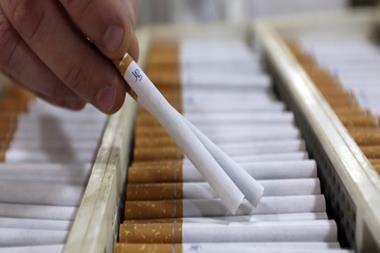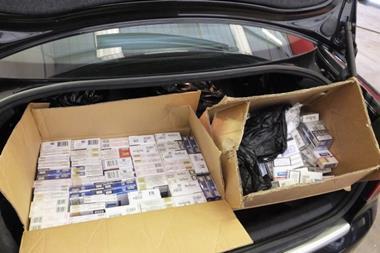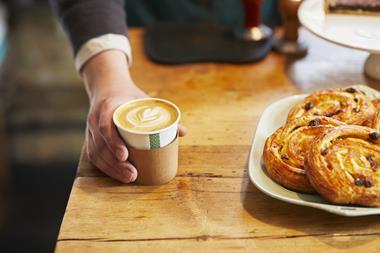With a burst of legislation creating huge disruption to the tobacco category, the industry is now getting used to the new regime.
For a long time the most crucial category for c-stores, tobacco is now the most confused. Successive waves of legislation have this year transformed both the size and the physical appearance of packs, leaving smokers puzzled, and stressed-out sales assistants fumbling to find the right brand for regular customers.
Since the 20 May deadline, it has been illegal to sell cigarettes in packs of less than 20 sticks, while hand-rolling tobacco now has to be in unit sizes of at least 30g. And all products have to be in generic packaging, a drab olive colour with minimal brand information, making it very difficult to differentiate between different skus.
Paul Cheema, director of Malcolm’s Stores in Coventry, speaks for most retailers about the pain caused by the change. “The transition was very disruptive to our business,” he says. “It’s been really hard for the team to be able to find the right products.”
Imperial Tobacco head of field sales Andrew Miller said the transition was “as smooth as could be expected, given the logistics involved”.
He continued: “With standardised packaging now a firm reality, the independent retail sector will naturally continue to play a crucial role in informing adult smokers around the significant changes to pack formats and branding which have occurred.”
Tobacco firm JTI also stressed the vital role played by store staff in maintaining tobacco sales. A spokesman said: “It is impossible to tell if there will be additional, unexpected challenges in the coming months. However, what we do know is that those retailers who prepared well and ensured their staff are well informed will have experienced the fewest challenges and will be continuing to maximise their sales from tobacco.”
In the wake of the transition to the new packs, Paul’s tobacco sales are not as strong as they once were, he reports.
“It has definitely hindered sales,” he says. And not just for tobacco either: “When people could buy 10s packs, they might visit every day, but now it’s a minimum of 20 you see them every other day instead,” he explains. “So it means you lose sales of other items, too, such as soft drinks or alcohol. Smokers are less brand loyal as well – they generally ask for the cheapest product.”
It’s an unexpected quirk of the EU and domestic plain packaging legislation which means that the cheapest product on shelf could be a cigar sku rather than a cigarette.
“Cigars still benefit from being exempt from the restrictions around minimum pack sizes and standardised packaging,” explains Jens Christiansen, head of marketing & public affairs at Scandinavian Tobacco Group UK, supplier of Café Crème and Moments brands.
“As a result, cigars can continue being branded beyond the product name, and can still be wrapped and sold individually, or in 10-packs.
“This means some cigars are now the cheapest option available on shelf, which may see them attract existing smokers from other categories and mitigate the drop in footfall left from cigarettes going to minimum 20-packs, as well as representing a higher margin than cigarettes. They will also benefit from much greater visibility than cigarettes due to their exemption from the plain packaging legislation. This presents a massive opportunity for tobacco retailers to use this to their advantage by stocking a good range of cigars, in all size segments, as some smokers look to switch to a value alternative to cigarettes, or indeed just a cheaper out-of-pocket price.”
The company’s Moments Panatella is rolling out in stores now, available in packs of five with an rrp of £4.20, making it the cheapest product on shelf within the small cigar segment.
Prices have unavoidably gone upwards in the roll-your-own (RYO) category, though, with the introduction of a minimum unit size of 30g.
Imperial’s Miller says: “While adult smokers’ purchasing habits have had to change following May’s enforced changes to a 30g minimum pack size, we have yet to see any significant impact on RYO sales in the independent channel. Imperial remains confident that smokers are continuing to enjoy rolling their own and are adapting their purchasing habits to accommodate the new larger pack sizes. However, this also means that smokers may now have less reason to visit their local retailer as frequently as before, signalling a potential hit on both footfall and basket spend.”
According to JTI, recent trends in the RYO market have seen an increase in popularity of box formats. Having increased sales value by 7.1% year on year (Nielsen), boxes now account for 31.3% of RYO pack sales.
To take advantage of this trend, retailers are advised to stock both pouch and box variants of RYO brands where available. With the current trend towards value set to continue, larger RYO packs are expected to become increasingly popular, the company maintains.
Paul has noticed that hand-rolling is increasing in popularity, despite the fact that shoppers have to make the considerable outlay of a minimum of 30g at a time, whereas once it might have been 12.5g.
“Hand-rolling has gone up for us, we’re selling more,” he says. “The packs are larger, but it’s still a value option for smokers. But at the same time, smuggling has increased massively, and you see lots of people with duty-free tobacco.
“The smugglers are using social media to sell it, it’s widely available on Facebook.”
A recent study by JTI found that one in 10 smokers in London admit to having purchased illegal tobacco through social media channels, such as Facebook. Furthermore, 37% of smokers in the capital have purchased illegal cigarettes, with 28% having being offered illegal tobacco products in the past year.
Quoting the HMRC Tax Gaps report, JTI estimates that illegal tobacco accounts for nearly 13% of the ready-made market, and 32% of RYO tobacco in the UK.
As might be expected, all manufacturers have a robust opinion on the illicit trade.
“Based on Imperial’s experiences in Australia – which has seen a 2.5% increase in the illegal tobacco trade since it transitioned to standardised packs in 2012 – we are concerned about a corresponding rise in the illicit trade in the UK moving forwards,” states Imperial’s Miller. “It is likely that honest retailers will need to be more vigilant than ever before.
“Through our salesforce and dedicated Anti-Illicit Trade team, Imperial continues to work collaboratively with legitimate traders and law enforcement to fight the illegal tobacco trade on a variety of fronts. We encourage retailers to either notify their designated sales representative or ring the Customs Hotline on 0800 59 5000 if they wish to report any suspicious activity in their area.”
Special report: How are retailers pricing tobacco?
With pricemarking no longer possible, what has the change in the law meant for tobacco prices across different store formats?
C-Store has partnered with ESA Retail to compare the prices of 10 key lines across 10 retail brands – single stores in the case of the symbol groups and consumer-facing websites in the case of supermarket chains.
Compared with the supermarkets, both c-stores and forecourts have been selling tobacco at a premium since the new legislation was introduced, but the gap between prices charged in different formats narrowed slightly between May and July, as Tesco edged a couple of prices upwards.
In May, c-store prices were an average of 9.2% higher across the whole selection of products, while in forecourt stores it was 13.8% higher. These differences reduced during June, and fell again in July to stand at 8% for c-stores and 11.3% for forecourts.
While sku prices have remained fairly constant during the quarter, there was some price realignment during July, with seven of the 10 items increasing in average price, while two (Marlboro and Amber Leaf) fell.
ESA Retail and C-Store will continue to monitor prices and report in future issues.
The changing face of tobacco
Despite the barrage of challenges facing the UK tobacco trade, stakeholders continue to look to the future, which includes alternative nicotine delivery products such as Philip Morris’ IQOS and an array of e-cig and vaping products.
Miller says: “Imperial is committed to the future of the tobacco category and, as the market settles down following May’s legislation, we continue to monitor trends to both cater for and react to changing consumer tastes. For instance, we have recently launched Rizla Natura papers and tips, a responsibly-sourced addition to the range.
“However, we also believe that variety of choice is a vital part of our offering and therefore wholeheartedly support e-vapour products (EVP) as part of our Next Generation Products strategy. Imperial continues to invest heavily in the sector via our subsidiary Fontem Ventures and their acclaimed product, Blu.”
Paul hasn’t given up on tobacco by any means, but in the long term it will probably occupy a different place in his shop. “We’re looking at putting our tobacco in drawers or installing an overhead gantry, and using the space for more premium spirits and gifting lines. Traditional tobacco doesn’t really earn its premium space any more.”
The Future of tobacco?
Philip Morris is rolling out its IQOS device in the UK, with two shops in London, a transactional website and a limited distribution of sticks, called Heets, to stores in the South-East.
The devices heat tobacco rather burning it, making it a “reduced risk” product from a health point of view. In time, Philip Morris aims to convert all existing adult smokers to such alternative products.
Paul, 48, agreed to give IQOS a try instead of conventional cigarettes. He writes: “I smoked 30 cigarettes a day, and my urge to quit was helped by an increasingly vocal partner who reminded me of the health risks – and the outrageous expense of my habit.
“I’ve tried the vape option, but never really found it satisfactory so I was more than ready to give IQOS a go. I have been using it for three weeks now and have smoked just three traditional cigarettes during that time – and this was because the charging device was confiscated coming back from a foreign holiday and I had an eight-hour gap before my ‘better half’ could race to the retail store in Soho’s Wardour Street, to replace it.
“I have felt no cravings for traditional cigarettes during my three weeks on Heets. There are downsides, though. As a technophobe, I struggled to understand how all the components worked at the start. There’s lot of on-going equipment maintenance to do, and the equipment needs regular charging. The Heets are not easily available, requiring an online order or a visit to the shop in Soho. But it still feels like a positive step.”
































No comments yet